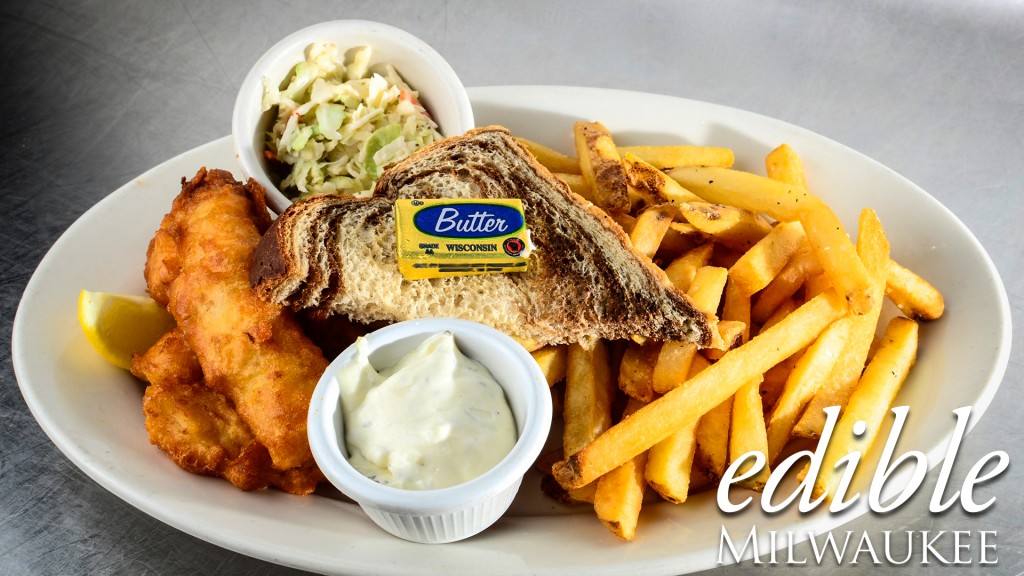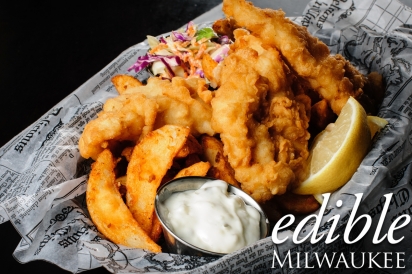Fish Fry: Not Just a Lenten Tradition
“Fish Fry Taste Conquers City in Wake of Return of Beer” declared the Milwaukee Journal on July 9, 1933. One Milwaukee tavern owner called fish and beer “a good combination” that “will go just as well in winter as in summer.”
While the declaration was perhaps a bit premature (the 21st Amendment repealing Prohibition was not officially ratified until December), many people had already begun to drink openly, and breweries had been allowed to produce beer with 3.2 percent alcohol. The connection between beer and fish was more than just taste. It was a business move.
“Bars offered fish fry as a way to get people—families—back in after Prohibition,” explains Janet Gilmore, a folklorist at the University of Wisconsin-Madison. “Fish tended to be cheap and it was an easy way to feed a crowd.”
Friday (and often Wednesday) is a kind of holy day in Wisconsin, with people gathering in taverns, supper clubs, VFW lodges and churches to eat fried fish and raise a glass of beer.
The main event is fish—often yellow perch, catfish, walleye, haddock, cod, bluegill, or smelt—battered and fried. It typically comes with potatoes in some form (baked, mashed, fried, hashed), bread and coleslaw, but this can vary. In areas of Danish settlement, like southeast Wisconsin, pea soup often accompanies the fish. In Milwaukee, the potato often takes the form of a pancake served with applesauce. At the Polish Center of Wisconsin, the Lent fish fry comes with pierogi.
No one really knows why fish fry became so universally popular in Wisconsin. It’s story draws on many threads, from Catholicism and Prohibition, to the state’s abundant water resources and the many different people who settled here.
“There’s an incredibly creolized character to fish fry,” Gilmore says. “It doesn’t come from one place but from many places, people and traditions.”
With plenty of streams, rivers and lakes, Wisconsin had offered Woodland Indians a ready supply of fish for centuries. Native peoples planted some crops, but agriculture was of secondary importance to the hunting, fishing and gathering of wild foods that formed a central part of their diet. The Ojibwe, for instance, depended on whitefish, often smoked and salted, from the Great Lakes. They later shared these practices with white settlers who often had their own fish foodways.
African Americans developed a fish fry tradition in the South during slavery. It became a social event after the Civil War, usually featuring drinking and dancing, as well as a reliable church fundraiser because of the availability of cheap fish and ease of preparation. African Americans likely brought this tradition north to Wisconsin where it melded with the traditions of other immigrants.
Those immigrants included Germans with their sense of gemutlichkeit—conviviality and good cheer—hallmarks of the fish fry today. Germans and Bohemians also introduced Wisconsinites to the bier stube tradition, opening taverns and drinking spaces that welcomed families. These differed from saloons where the all-male patrons tended to stand. The combination of family and drinking similarly made the supper club a popular Wisconsin tradition.
To bring in more customers, many taverns began serving a free lunch in the late 19th century. Fish was cheap, abundant and, as tavern owners noted, tasted great with beer. These meals encouraged the thirst for and subsequent sale of beer.
Gilmore isn’t sure why the fish was fried rather than cooked by another method but speculates that it had much to do with American affection for fried foods and general aversion to eating fish. Fish consumption has historically been low in the United States as compared to the rest of the world, making up less than 10 percent of Americans’ consumed animal protein. Frying masked its fishy flavor while the saltiness increased thirst—good news for tavern and supper club owners.
Add to this Wisconsin’s large Catholic population, many of whom did not eat meat on Fridays. Technically, it was the flesh of warm-blooded animals that was off limits so coldblooded fish became an easy substitute. In the 1930s, the Catholic Church reaffirmed meatless Fridays during Lent for its members in observance of Christ’s crucifixion. Vatican II ended the Friday meat ban for Catholics in the 1960s, but by then, eating fish had little to do with organized religion.
“Other places have fish fry, like Minnesota and Michigan, as they are often too quick to point out when Wisconsin fish fry comes up,” Gilmore says. “But these tend to happen only during Lent. There’s a huge range of fish fry across the state.”
How and why this Catholic meatless tradition spread to a whole community and thrived outside of Lent is a question without an easy answer, according to Gilmore.
No matter how, where, and why they began, fish fry took off in Wisconsin.
Until the mid-20th century, lake perch, once a staple of the Milwaukee diet, and walleye were the most popular fish. But shortages led to the addition of ocean fish like haddock and cod. The collapse of Lake Michigan perch fisheries in the 1990s led to a commercial ban on perch fishing that essentially eliminated local perch from the table. Today, haddock and cod are the most common fish seen at a fish fry, with most perch coming from Lake Erie and Lake Winnipeg.
But local perch does appear on some menus thanks to aquaponics. Will Allen began growing yellow perch in his system at Milwaukee’s Growing Power in collaboration with UW-Milwaukee’s School of Freshwater Sciences. These fish reach maturity in one year, as opposed to three years in the wild.
Among those to benefit from the local perch are Locavore at the Potawatomi Casino and the Lakefront Brewery Beer Hall, the latter of which serves its popular fish fry along with live polka. The line to get in often stretches out the door.
That’s another feature of the Wisconsin fish fry: the wait. Waiting for a table in a crowded dining area is a Friday fish fry tradition. Some places, like Serb Hall, which can and does seat hundreds every week, also offers a drive-through with lines of cars stretched down the block.
Of course, fried isn’t the only way fish is served in Wisconsin. Fish boils became particularly popular in Door County, but Gilmore says that fishermen often boiled fish at home and for parties.
“People went out for [fish boils] sometimes, but it was really something you did at home,” Gilmore says.
Legend has it that Scandinavians brought the custom to the Midwest. Parties featuring boiled seafood, particularly crayfish, are common in Sweden and Norway.
What’s perhaps most remarkable about fish fry in Wisconsin, however, is that despite its popularity and ubiquity, fish fry claims no experts. Even Gilmore, despite frequently speaking on the topic and her academic work on commercial fishing and fishing culture on rivers and lakes, says there’s still much to be learned and understood about the origins of Wisconsin fish fry.
But she knows enough about fish fry to understand its importance to the state.
“What’s really distinctive is that people go out for it every week,” Gilmore says. “It’s so much in the fabric of what we do.”
Gilmore speculates that many people may not even care whether the fish tastes good.
“Fish fry is about the ambience of a place and having fun with your friends and family,” explains Gilmore. “That sociability is what makes this tradition uniquely Wisconsin.”










